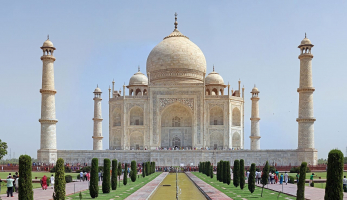Top 15 Most Breathtaking Monasteries in the World
There is a certain element of mystery that goes along with religion. There is always one site of worship that blends beauty and calm, regardless of the ... read more...religion. These monasteries are not only serene, but they are also works of incredible architecture. Each of these monasteries stands as a unique piece of art that exemplifies the aesthetics and tenets of its respective religion. The monasteries listed here, whether they are little or huge in size, hold great significance for people who want to one day go to these wonders. Let's discover the most breathtaking monasteries in the world now.
-
The collection of Eastern Orthodox monasteries that make up Meteora is one of Greece's most well-known and picturesque attractions, second only to Mount Athos in terms of prominence. Built on top of enormous granite columns that abruptly emerge from the ground, the monasteries from the fourteenth century provide commanding views of the Plain of Thessaly. Meteora still contains six active monasteries, which originally numbered a total of 24, and are home to chapels, cathedrals, and caverns, as well as magnificent murals and historic religious artifacts. Visitors must climb several flights of stone stairs carved into the rock in order to reach the spectacular monasteries of Meteora. Views of the beautiful countryside below are magnificent from these winding trails.
Due to the complex's stunning design, religious importance, and aesthetic value, Meteora was included into the UNESCO World Heritage List in 1988. The term is etymologically linked to meteor and signifies "lofty" and "elevated". These structures' architecture is largely athonite in nature. Six are still in operation today, but the majority of the others are in ruins. They are currently reachable by steps and trails carved out of the rock formations, perched upon steep cliffs.
Location: Thessaly, Greece

placestodiefor.blogspot.com 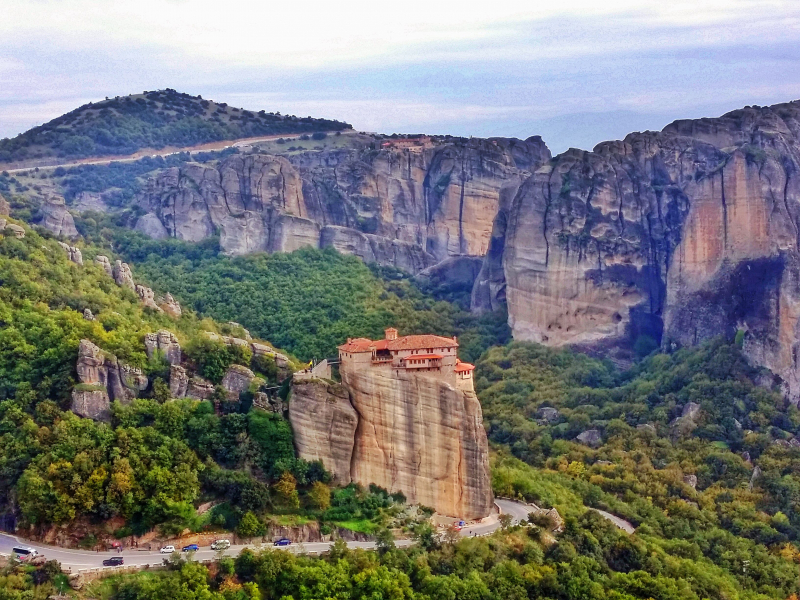
Pinterest -
Taung Kalat has a significant religious connotation. The same-named mountain, which was formerly a volcano, is where the monastery is situated. This truth is directly connected to monks' beliefs and is reflected in the fables that are told about the temple. Particularly, it is said that this volcano is home to natami spirits or living spirits. They are considered demigods by the locals. They formerly served as exemplars of the old nobility, whose veins were filled with royal blood. They were all slain, but at relatively different times and under quite different conditions.
After some time, the people of Myanmar started to revere them as saints and built modest memorial statues in their honor. There are around 37 of them in all, and they are all gathered under the Taung-Kalat monastery's roof. Many pilgrims who fervently believe in the existence of nata provide the spirits with gifts of raw meat in an effort to coax them and get their sort of blessing in a variety of situations. By the way, if you are prone to superstitions as well, it may be worth your while to visit the monastery and ask the spirits for guidance while wearing red or black clothing, as these are said to be the nats' preferred hues. Two festivals, Nyon and Nada, are now conducted in May and November at the Buddhist monastery of Taung-Kalat in remembrance of these spirits.
Location: Mandalay Region, Myanmar

cattour.vn 
cattour.vn -
The Tiger's Nest is one of Bhutan's most revered and beautiful locations, perched perilously on a cliffside around 900 meters above the Paro Valley bottom. Gyalse Tenzin Rabgye skilfully constructed the monastery around the cave after having it placed in the upper Paro cliffside, and it has since come to represent Bhutan's culture. It holds a well-known celebration called Tsechu (Tshechu) honoring Guru Padmasambhava every spring in March or April.
According to mythology, Padmasambhava rode a flying tiger to Paro Taktsang, where he meditated. The Taktsang Senge Samdup cave, where Guru Padmasambhava meditated for three years, three months, three weeks, three days, and three hours in the 700s, is close to where the temple complex is located. Padmasambhava, who serves as Bhutan's tutelary god, is credited with bringing Buddhism to that nation.
It's not simple to go to the monastery. It takes roughly two hours to ascend the 1 km (3000 ft) from the valley bottom. The route upward is rather steep and at times seems to vanish. You will be at an altitude of roughly 3 km (10,000 ft) when you arrive at the Tiger's Nest entrance. You'll be rewarded with an amazing valley vista and the seclusion of a Buddhist temple. Remember that shoes and camera gear are not permitted within the monastery.
Location: Paro Taktsang, Bhutan

thepetitewanderess.com 
destinationsmagazine.com -
St. George Monastery is situated in the West Bank in the charmingly barren Wadi Qelt valley, halfway between Jerusalem and Amman. The structure, which was constructed into the side of a cliff and dates back to the 420s, can only be reached by going down a difficult route and crossing a pedestrian bridge across the canyon. The monastery, which is still inhabited by Greek Orthodox monks, has several significant artifacts as well as historic chapels and churches. With the dry, rocky landscape of Wadi Qelt all surrounding it, St. George Monastery, a highly famous pilgrimage site, provides for a stunning sight.
Legend has it that when they approached, the shape of a rider vanished. On the mountain's summit, a stone with the marks of human and horse hoof was discovered. There was also a Saint George icon discovered. The image was transferred to the Church of Saint John the Baptist in Kerch, one of the oldest churches, but it magically reappeared on top of the mountain. The church's priest provided the solution to the issue. On April 23, the day of Saint George's commemoration, the icon was to be transported in a procession to the location of the appearance each year until the monastery was built on the spot as promised.
Location: Wadi Qelt, West Bank Jerusalem

TripAdvisor 
Flickr -
In the Spiti Valley of Himachal Pradesh, Lahaul and Spiti district, India, Kye Gompa is a Tibetan Buddhist monastery of the Gelugpa sect that is situated on top of a hill at an elevation of 4,166 meters (13,668 ft) above sea level, near to the Spiti River. It serves as a center for lama training in religion and is the biggest monastery in the Spiti Valley. It was said to have had 100 monks in 1855. The monastery is devoted to Lochen Tulku, the renowned translator Lotsawa Rinchen Zangpo's 24th incarnation. It is 210 kilometers (130 miles) from Manali and roughly 12 kilometers (7.5 miles) north of Kaza.
The monastery's walls are decorated in paintings and murals, which are examples of the monastic architecture that emerged as a consequence of Chinese influence in the 14th century. Buddha pictures may be seen among the antique texts and murals in the Kye monastery's collection. The first floor, which is primarily subterranean and used for storage, has three levels. Murals in one chamber, the Tangyur, are lavishly decorated. Numerous monks' quarters and the exquisitely designed Assembly Hall are located on the ground floor. Kye Gompa, one of three in Spiti, presently belongs to the Gelugpa sect together with Tabo Monastery and Dhankar Gompa. The "Kachen Dugyal Memorial Old Aged - Handicapped Society," which offers housing for a number of elderly and crippled individuals, has recently been housed within the monastery.
Location: Kibber Village, Spiti, Himachal Pradesh
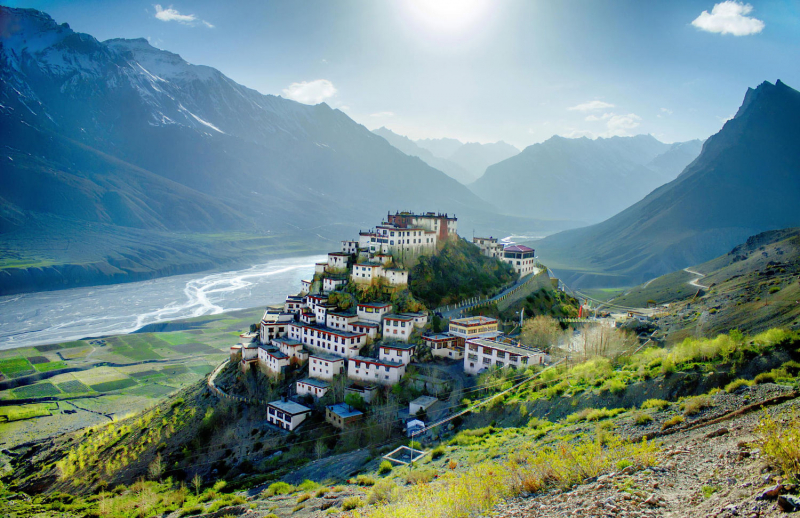
karilikelikes.com 
free4kwallpapers.com -
The Sinai Peninsula is home to Saint Catherine's Monastery, also known as the Sacred Autonomous Royal Monastery of Saint Katherine of the Holy and God-Trodden Mount Sinai. It is located close to the Egyptian town of Saint Catherine at the head of a canyon at the base of Mount Sinai. The monastery bears Catherine of Alexandria's name. The monastery, which is run by the independent Church of Sinai, a division of the larger Greek Orthodox Church, was designated a UNESCO World Heritage Site in 2002 due to its distinctive significance in the Christian, Islamic, and Jewish traditions. The neighboring Mount Sinai, where Moses is reputed to have received the Ten Commandments, is often included in the itinerary of those who go there.
It is the oldest continually inhabited Christian monastery in the world, having been constructed between 548 and 565. Along with possibly the largest collection of early Christian icons, including the earliest known representation of Jesus as Christ Pantocrator, the site also houses the oldest continuously running library in the world, which contains rare or unique works like the Codex Sinaiticus and the Syriac Sinaiticus. The monastery was constructed near the site of what is typically thought to be where Moses saw the burning bush. The patronal feast of the monastery is the Feast of the Transfiguration. It has become a favorite site of pilgrimage.
Location: Saint Catherine, South Sinai Governorate, Egypt
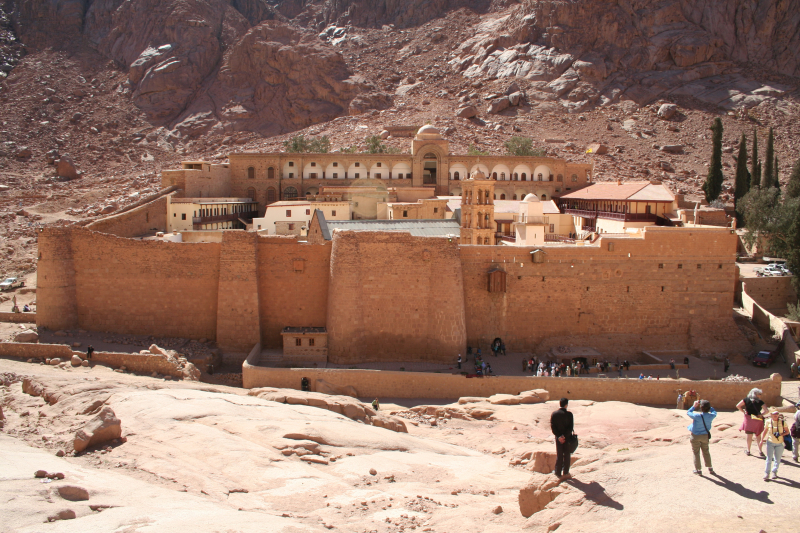
spiritualtravels.info 
alittlenomad.com -
The Ostrog Monastery is a Serbian Orthodox Church monastery that is located in Montenegro, high up in the massive rock of Ostroka Greda, against an almost vertical backdrop. It honors Saint Basil of Ostrog (also known as Sveti Vasilije Ostroki), who is buried here. The Bjelopavlii plain can be viewed from the monastery. The monastery is in the Danilovgrad Municipality, 15 kilometers from Niki and 50 kilometers from Podgorica. The most frequented pilgrimage site in Montenegro is the Ostrog Monastery. The monastery, which is a part of the Serbian Orthodox Church, was established by Vasilije in the 17th century and is hewn into the cliff face of the substantial Ostroska Greda rock.
Numerous Orthodox, Catholic, and Muslim travelers worship here in the hope that their illnesses would be cured since this amazing fresco-covered cave-church housing Saint Basil of Ostrog's remains. The Ostrog Monastery is home to outstanding artwork and architecture as well as stunning views of the Bjeloplavlici plain. One of the most popular tourist destinations in the Balkans is the Orthodox monastery of Ostrog. Over 100,000 people visit it each year. Individually or in groups, Christians from all over the world travel there. It stands for the site where all religious groups converge, including Muslims, Catholics, and Orthodox. According to pilgrims' accounts, many people have been healed and helped to decrease their life's challenges by praying beside his body.
Location: Никшић, Danilovgrad

Craghoppers 
michaeltyler.co.uk -
In the isolated Lungnak Valley in southern Zanskar, in the Himalayan region of Ladakh, in Northern India, is where you'll find the Buddhist monastery known as Phuktal Monastery or Phuktal Gompa. One of the few remaining Buddhist monasteries in Ladakh that can only be accessed on foot is this one. During the warmer months, supplies are delivered to the monastery on horses, donkeys, and mules; during the freezing winters, they are conveyed via the frozen Zanskar River. At the now, it is a day's walk from Village Cha or Village Khangsaar, the end of the road coming from Padum, however a road is anticipated to be built up to the monastery. With the assistance of participants of the Global Himalayan Expedition (GHE), solar energy was installed at the Phugtal monastery in 2016.
It is constructed like a honeycomb into the cliffside. A significant tributary of the Lungnak River has a lateral gorge that includes the cliff (Lingti-Tsarap River). In addition to the original cave and the sacred spring, which are both preserved, the monastery presently includes a major temple, prayer halls, a library with rare religious writings, apartments and living quarters, teaching facilities, a kitchen, and other buildings. A little over 70 monks live there. There is a stone inscription that commemorates Alexander Csoma de Krös' time in Phuktal between 1826 and 1827, when he visited Ladakh and began work on the first English-Tibetan dictionary.
Location: Zanskar, Kargil district, Ladakh, India

Pinterest 
tripexperienceblog.com -
In Hunyuan County, Datong City, Shanxi Province, China, next to Mount Heng, there is a temple known as The Hanging Temple, also known as Hengshan Hanging Temple, Hanging Monastery, or Xuankong Temple. It is erected onto a cliff 75 meters (246 feet) above the ground. Datong, 64 kilometers (40 miles) to the northwest, is the nearest city.
The Hanging Temple is one of the most popular tourist destinations and historic locations in the Datong region, along with the Yungang Grottoes. This temple, which was constructed more than 1,500 years ago, is significant not only for its placement on a steep cliff, but also because it is the only one still in existence that combines the three classic Chinese philosophies or faiths of Buddhism, Taoism, and Confucianism.
Oak crossbeams that are inserted into cliff-cut holes hold the building in place. The bedrock serves as the primary sustaining framework. The body of the monastery hangs from the center of the cliff beneath the conspicuous peak, shielding it from rain erosion and sun burn. The monastery is situated in the little canyon basin. The Hanging Monastery is shielded from the weather in a tiny canyon basin and overlooks a stunning valley with Mount Heng visible in the distance.
Location: Hunyuan County, Datong City, Shanxi Province, China

flickriver.com 
Fine Art America -
The Theotokos-centered Sümela Monastery is a Greek Orthodox monastery situated in the Pontic Mountains near Karada in the Maçka neighborhood of Trabzon Province in contemporary Turkey. It is a location of immense historical and cultural value as well as a significant tourist destination inside Altndere National Park. It is nestled in a high rock at an elevation of around 1,200 meters facing the Altndere valley. On September 22, 2015, the monastery was temporarily closed to the public for one year in order to address an upsurge in rock falls; this was then extended to three years. For visitors, it reopened on May 25, 2019. One of Trabzon's most significant historical and touristic attractions is the monastery.
Due to the need for repairs and field work, the Monastery was closed to tourists on September 22, 2015, for a period of three years. In 2019, on May 18, it reopened. Video footage from 2022 displayed dancing and contemporary music at the location. An explanation was provided that this was done to encourage tourism after online outrage that the medieval monastery had been converted into a dance club. However, its spectacular rock-hewn cathedral, which is covered in vibrant, centuries-old murals, is without a doubt the attraction. Sumela Monastery is a very significant and spectacular historical and cultural landmark that is protected and conserved by the Turkish government as a museum and is only reachable by climbing up several long and curving stone stairs.
Location: Maçka, Trabzon Province, Turkey
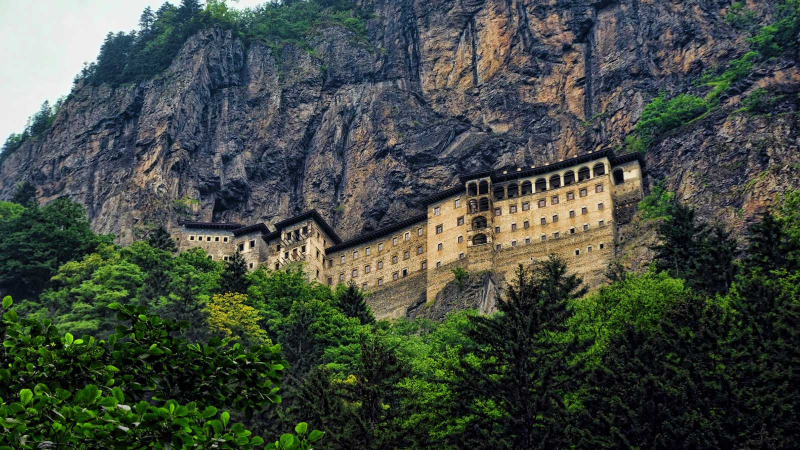
travelatelier.com 
blogspot.com -
The remnants of an early medieval hermitage may be seen on Katskhi Pillar, a natural limestone monolith that towers impressively above its surroundings. The granite outcrop in Georgia's western region has 40-meter-tall sheer slopes. Its isolation meant that its tiny chapel and hermit cells were undiscovered for many years. Locals had long viewed the pillar as a representation of the True Cross, and it wasn't until a monk moved there in the early 2000s that it was fully rebuilt. Katskhi Pillar is a magnificent structure, even though it is beyond limits to the general public. Its conspicuous pinnacle is surrounded by gorgeous scenery and stands out charmingly against the sky.
Locals revere the 150 m2 rock, which includes apparent church ruins on its upper surface, as the Pillar of Life and the True Cross, and tales have sprung up around it. It was not climbed or surveyed by researchers until 1944. From 1999 to 2009, it was subjected to more thorough investigation. According to these investigations, the ruins were an early medieval hermitage from the ninth or tenth century. The hermitage may have still been there at that time, according to a Georgian inscription that has been paleographically dated to the 13th century. In the 1990s, the pillar's connected religious activity was resurrected, and by 2009, a state-funded effort had rebuilt the monastery structure.
Location: Katskhi, 5 km from the town of Chiatura, Chiatura District, Imereti Province (Mkhare), Georgia

blogspot.com 
orangesmile.com -
Mount Athos is one of the most significant hubs of Eastern Orthodox monasticism since it is home to not one, but twenty monasteries. It may be found in Greece's northeast. Often referred to as the ‘Holy Mountain’, the peninsula upon which it rests is only accessible by boat, and only men are authorized to explore its steep, wooded slopes and secluded monasteries. Monks have resided on the peninsula since the Byzantine era. All of the Athonite monasteries are filled with magnificent antiquities and pieces of art, and there is a lot of beautiful old architecture on display. Visitors may witness the ages-old monastic way of life, participate in religious services, and trek between monasteries on Mount Athos.
The mountain and its corresponding portion of the peninsula have been ruled as the monastic community of Mount Athos, an autonomous area within the Hellenic Republic, with the rest of the peninsula falling under the administration of the municipality of Aristotelis. With a lengthy history of Christian habitation dating back at least to the Byzantine era and AD 800, Mount Athos is renowned for its medieval monastic traditions. Mount Athos was included to the UNESCO World Heritage List in 1988 due to its lengthy religious significance, the monasteries' maintained agricultural architecture, and the preservation of the local flora and animals.
Location: Greece

pappaspost.com 
freeImages -
In the Syunik Province in southeast Armenia, close to the settlement of Tatev, lies the huge basalt plateau where the 9th-century Tatev Monastery, an Armenian Apostolic monastery, is situated. The monastery is typically referred to as "Tatev." The monastery complex is situated on the edge of the Vorotan River's steep valley. In the past of the area, Tatev—known as the bishopric seat of Syunik—played a vital role as a hub of economic, political, spiritual, and cultural activity. One of the two most well-known monasteries in Armenia, along with Noravank in the Vayots Dzor province, is the Monastery of Tatev.
One of the most significant Armenian medieval institutions, the University of Tatev, which advanced science, theology, and philosophy as well as the reproduction of books and the development of miniature art, was housed at the monastery throughout the 14th and 15th centuries. During one of the most difficult eras in history, academics from Tatev University helped to preserve Armenian culture and belief. This is seen from the magnificent paintings and magnificent architecture. The three heavenly cathedrals are surrounded by sturdy towers, opulent libraries, and expansive dining halls. The Wings of Tatev cable-car, which provides unrivaled views of the picturesque canyon below, may take passengers to the significant historical, cultural, and religious landmark.
Location: Tatev, Syunik Province, Armenia
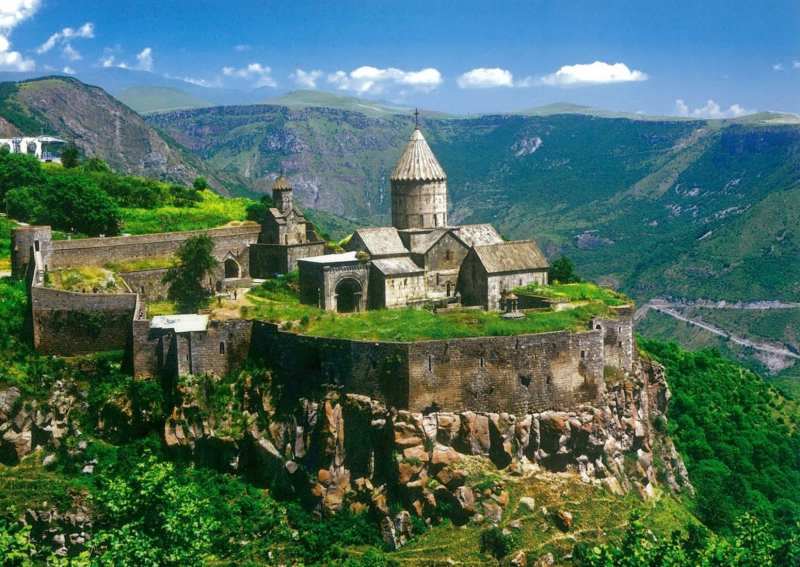
blogspot.com 
discoveryrussia.com -
Dhankar Gompa is perched atop a rocky spur overlooking the meeting of the Spiti and Pin Rivers high in the Himalayas in the extreme north of India. The fort monastery is located right above the settlement of Dhankar, which served as the former capital of the Spiti Valley Kingdom and is surrounded by notable peaks and lunar-like scenery. The whitewashed walls of the monastery, which is thought to be over a thousand years old, are home to some exquisite courtyards and ceremonial rooms, with its stunning statue of Vairocana serving as one of the primary features. It also offers breathtaking views of the valley, rivers, and mountains that surround it.
In the little town of Shichilling, which is located under the Gompa, you'll find the brand-new Dhankar Monastery, which is home to 150 Gelug school monks. In addition to the surrounding bleak, lunar terrain, Dhankar Gompa is home to several crumbling thangkas and a statue of Vairocana that is made up of four figures sitting back-to-back. In the gompa, there is a little museum. Dhankar Gompa was named one of the top 100 most endangered sites in the world in 2006 by the World Monuments Fund. Dhangkar Initiative, a nonprofit organization, is striving to coordinate its conservation. A motorable road, suitable mainly for small vehicles, diverges from the main Kaza-Samdu route for Dhankar at a location about 24 kilometers from Kaza.
Location: Himachal Pradesh, India

fineartamerica.com 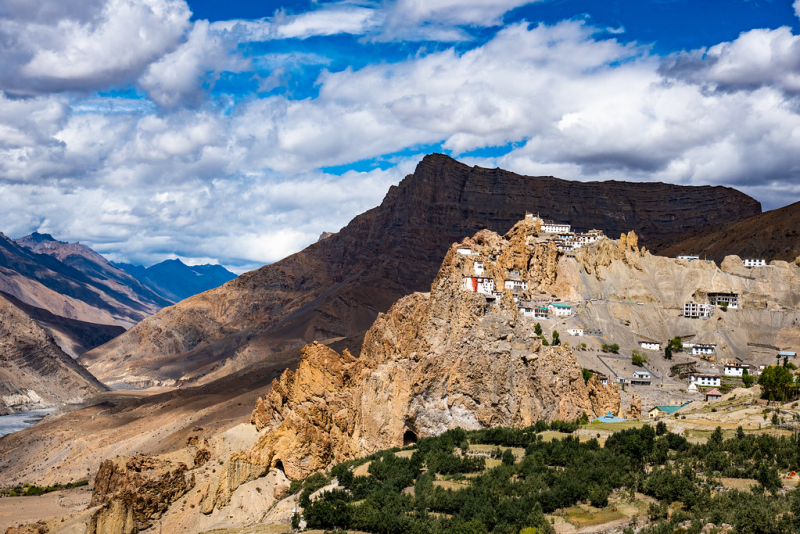
Flickr -
The Great Meteoron, as the name suggests, is the largest and oldest monastery in Meteora. The largest and oldest of all is the Holy Monastery of Great Meteoron, which is situated in Meteora, Greece. The monastic complex was known as the monastery that is "hung in the air" (meteoro) due to the enormous rock that formed the cliff on top of which it was constructed. Saint Athanasios the Meteorite established the Great Meteoro Monastery, also known as "Megalo Meteoron", in the fourteenth century. He is credited with being the monastery's initial founder and with initiating organized monasticism over the whole Meteora region. For this reason, the establishment of this monastery is seen as a turning point for the Meteora region, or better still, as the start of organized monasticism.
Midway through the 16th century, the Great Meteoron monastery's main church was constructed. It is embellished with lovely murals from the 16th century and is devoted to the transfiguration of our Lord and Savior. Spend some time admiring the creative features of the church's interior, which has some of the greatest examples of Greek post-Byzantine art. Don't pass up the chance to explore the monastery's museum, which is home to priceless religious artifacts and historical codices. The Great Meteoron monastery provides breathtaking panoramas of the surroundings.
Location: Meteoron, Kalampaka

freeImages 
freeImages

























